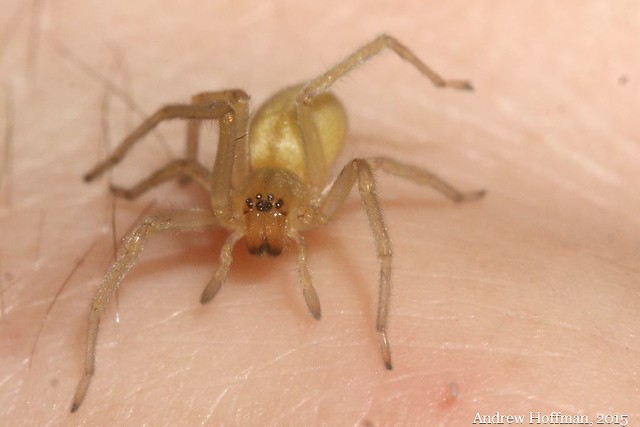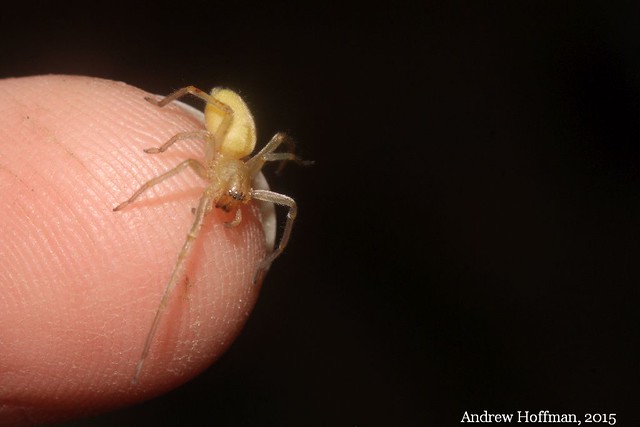I recently stumbled upon a strange new spider in our apartment bathroom. This spider was a small, dingy yellow creature and it dwelt in a tubular silken retreat along the corner of the ceiling. After getting a closer look, I realized it was one of the dreaded yellow sac spiders. These spiders have earned a bad reputation for having a nasty bite(3). So what does one do with a potentially dangerous spider in the home? Like any eager student of nature, I decided this spider warranted an up close and personal examination. But first, let’s review the facts about this much maligned little creature.
Sac spiders in the genus Cheiracanthium are small (less than ½ in.) and hide in silk-spun tubular retreats by day (hence the name)(2). There are two species of yellow sac spider in North America; one a native and the other an alien invader. Cheiracanthium inclusum is a native spider to North America and is common in a wide range of habitats, including agricultural areas. In fact, this spider gets special mention in a USDA article on important insect control for agricultural production(1). However, its close relative, Cheiracanthium mildei, is nonnative and is a common household spider. Since its arrival from Europe in the early 1900’s, this spider has been blamed for many an accidental spider bite in the home. The spiders were not only blamed for painful bites, but also for causing necrotic wounds, previously thought to be unique to spiders in the genus Loxosceles (brown recluse). The potential danger in the necrotic bite of these sac spiders was generally accepted until relatively recently. In 2006, Richard Vetter and his colleagues published a paper titled “Verified bites by yellow sac spiders (genus Cheiracanthium) in the United States and Australia: Where is the necrosis?,”(4) effectively busting this myth.
After reviewing more than 50 cases of confirmed bites from sac spiders in the genus Cheiracanthium, the authors conclude that there is almost no evidence to support the notion that these spiders are truly dangerous. Most bites resulted in pain (sometimes intense) lasting for quite some time with more systematic symptoms occurring only rarely and, as you may have guessed, no necrosis. The previous accounts of dermonecrotic skin lesions were deemed circumstantial and largely based on lab studies with rodents, or hospital patients admitted with skin lesions that could not be certainly linked to a spider bite. Though it is troubling that some physicians are so eager to blame spiders for mysterious skin lesions, it is refreshing to see the tiny yellow sac spider’s name cleared.
This study was particularly welcomed after finding that yellow sac spiders in our apartment complex. I carefully coaxed the small female spider from her silken retreat in the corner near our bathroom ceiling to get a better look. Feeling that the worst blow she could deal me would be little more than a sting, I decided to test her temperament. I allowed her to crawl over my hands for some time and watched as she frantically attempted to escape. She would run to my fingertips, madly flail her legs around while fixing a silk line to my finger, and then gracefully descend on a nearly invisible strand. The spider was not only non-aggressive; she was downright timid. I decided that I was okay living in an apartment with her family. Besides, someone has to be around when the fruit flies return!
References:
- Durham, S., A. Flores, & D. Comis. 2009. Working after hours a nighttime view of insect predation. United States Department of Agriculture. Link
- Jacob, S. 2002 (revised 2015). Agrarian sac spider and longlegged sac spider. PennState College of Agricultural Sciences. Link
- Spielman, A. & H.W. Levi. 1970. Probable envenomation by Chiracanthium mildei; a spider found in houses. American Journal of Tropical Medicine and Hygeine 19:729-732. Link
- Vetter, R.S., G.K. Isbister, S.P. Bush, & L.J. Boutin. 2006. Verified bites by yellow sac spiders (genus Cheiracanthium) in the United States and Australia: Where is the necrosis? American Journal of Tropical Medicine and Hygeine 74:1043-1048. Link


One thought on “Blame it on the Sac Spider”